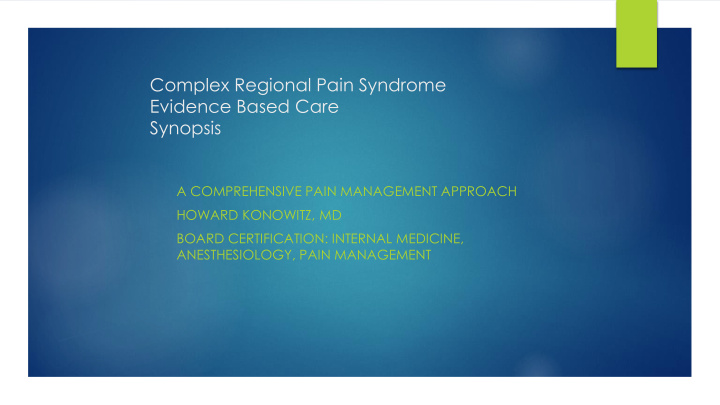



Complex Regional Pain Syndrome Evidence Based Care Synopsis A COMPREHENSIVE PAIN MANAGEMENT APPROACH HOWARD KONOWITZ, MD BOARD CERTIFICATION: INTERNAL MEDICINE, ANESTHESIOLOGY, PAIN MANAGEMENT
National Guidelines and international evidence basis for the diagnosis and treatment of Complex Regional Pain Syndrome REFERENCES: AHRQ , .UP-TO-DATE, WASHINGTON STATE DEPARTMENT OF LABOR AND INDUSTRIES, ROYAL COLLEGE OF PHYSICIANS GUIDELINES FOR CRPS MAY 2012,
Washington State Department of Labor and Industries Work Related Complex Regional Pain Syndrome Diagnosis and Treatment Diagnostic Criteria Budapest Consensus Treatment Physical and Occupational Therapy (Therapists familiar with CRPS) Medications for pain control or modulation Psychological therapy Sympathetic Blocks (initial set up to three and check response, image guidance) (regional blocks) Multidisciplinary pain programs
Budapest Criteria
The Literature basis for state of Washington 144 studies and 28 cited and expert consensus. Early Diagnosis and treatment for better outcomes! Physical and Occupational Therapy functional goals, focused desensitization, patient journal, progressive weight bearing or fine motor tasks. Medications for Pain Control no high quality evidence but categories of medication often used. Selection based on symptoms. Inadequate pain control inhibits movement and therapy Sympathetic blocks standard of treatment. Initial trial of up to 3 blocks. Psychological management to address fear-avoidance behavior patterns. Multidisciplinary pain programs
What does the literature not authorize. Not authorized treatment in Washington Surgical Sympathectomy Spinal Cord stimulation Ketamine infusions Not recommended in Great Britain Intravenous regional sympathetic blocks (IVRSB) with guanethidine should not be used routinely in the treatment of CRPS, as four randomized controlled trials have not demonstrated any benefit. SCS recommended in Great Britain Spinal cord stimulation should be considered in patients with CRPS who have not responded to appropriate integrated management, including specialized pain physiotherapy. This treatment can be carried out only in specialized centers (see BPS website* and NICE guidance** for further information). Pain specialists should be aware that there is some evidence that the efficacy of this treatment generally declines over time.9
What needs more research In some centers, interventions (including injection of local anesthetic solution to the sympathetic chain, epidural catheters delivering a local anesthetic and clonidine, or interscalene indwelling catheters) are used with an aim of ‘breaking the cycle’ of pain or aiding physiotherapy. Although there is currently no conclusive evidence for this practice from randomized controlled trials, considerable anecdotal evidence suggests that pain levels can remain low after such intervention. More research is needed before these methods can be formally recommended.
Address sleep disorder anxiety and depression Pain is typically the leading symptom of CRPS and is often associated with limb dysfunction and psychological distress. For those in whom pain persists, psychological symptoms (anxiety, depression), and loss of sleep are likely to develop, even if they are not prominent at the outset. Therefore an integrated interdisciplinary treatment approach is recommended, tailored to the individual patient. The primary aims are to reduce pain, preserve or restore function, and enable patients to manage their condition and improve their quality of life. Royal college of Physician guidelines
There Is No Single Laboratory Test to Diagnose RSD/CRPS . THEREFORE, THE PHYSICIAN MUST ASSESS AND DOCUMENT BOTH SUBJECTIVE COMPLAINTS (MEDICAL HISTORY) AND, IF PRESENT, OBJECTIVE FINDINGS (PHYSICAL EXAMINATION), IN ORDER TO SUPPORT THE DIAGNOSIS.
Pharmacotherapy Rational polypharmacy to match the different sites in the neuroaxis Choices include the consideration of comorbidities Depression, anxiety, insomnia Long term goals of individual patient
Medications chosen by clinical presentation and response. Medications . Several different classes of medication have been shown to be effective for CRPS, particularly when used early in the course of the disease. No drug is approved by the U.S. Food and Drug Administration specifically for CRPS. No single drug or combination of drugs is guaranteed to be effective in every person.
Colorado Division of Workers' Compensation. Complex regional pain syndrome medical eatment guidelines. Denver (CO): Colorado Division of Workers' Compensation; 2011 Dec 27. 107p Therapeutic injections Sympathetic injections Trigger point injections Peripheral nerve blocks Other intravenous medications and regional blocks Continuous brachial plexus infusions (not recommended) Epidural infusion (not recommended)
Colorado Workers Comp Guidelines Operative Therapeutic Procedures * Neurostimulation (While there is no evidence demonstrating effectiveness for use of SCS with for CRPS II, it is generally accepted that SCS can be trialed.) Peripheral nerve stimulation (There are no randomized controlled studies for this treatment) Intrathecal drug delivery ( Not generally recommended. Requires prior authorization. Due to conflicting studies in this population and complication rate for long-term use,) Sympathectomy (This procedure is generally not recommended and requires prior authorization. Amputation (recurrent infections ie gangrene))
Better Research Needed…. Expert practitioners in each discipline traditionally utilized in the treatment of CRPS systematically reviewed the available and relevant literature; due to the paucity of levels 1 and 2 studies, less rigorous, preliminary research reports were included. The literature review was supplemented with knowledge gained from extensive empirical clinical experience, particularly in areas where high-quality evidence to guide therapy is lacking. Public Med 2331950
Recommend
More recommend